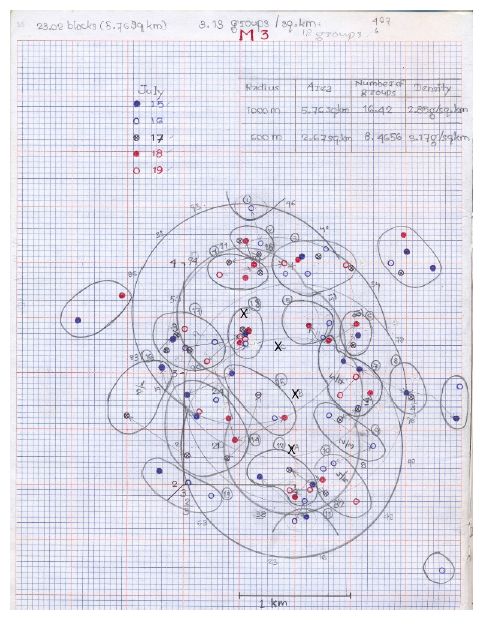Counting gibbons: The evolution of sample methods
Main Article Content
Abstract
Estimating the population sizes of endangered species in the natural environment is a major activity of conservationists. Dierent types of animals require dierent methods of population census and sampling. Statistical standards of sampling populations have increased and new analytical software has reduced the time needed for manual computation, but increased the need for standardized data collection methods. Here I discuss the methodology used in gibbon population sampling and current discussions regarding the best method of data analysis. Gibbons are most effciently sampled by listening for their duetted songs given by mated reproductive pairs in small territorial groups. Several problems have to be overcome in field data collection and analysis: the decline in sound detection with distance, the possibility of groups singing more than once in a day, the probability of a group singing (or not singing) on a given day, and determination of the total area that the audible groups are occupying. The traditional way of dealing with these problems is by triangulating on singing groups from several simultaneous listening posts, and carefully mapping the locations of groups. There are biases present in most methods and ways overcoming bias using newer methods are discussed. Survey of gibbons and other animals is a constantly evolving process, and there is still no universally accepted methodology.
Article Details
References
IUCN red list of threatened animals, IUCN, Gland, Switzerland, 1996.
J. A. Skalsky, K. E. Ryding, J. J. Millspaugh, Wildlife demography: Analysis of sex, age, and count data, Burlington MA,USA: Elsevier Academic Press, 2005.
J. T. Marshall, E. R. Marshall, Gibbons and their territorial songs, Science 193 (1974) 235 – 237.
J. J. Raemaekers, P. M. Raemaekers E. H. Haimoff, Loud calls of the gibbon (Hylobates lar): Repertoire, organization and context, Behaviour 91 (1984) 146 – 189.
J. O. Ellefson, A natural history of white-handed gibbons in the Malayan peninsula, In D. M. Rumbaugh (ed.), Gibbon and siamang: vol. 1. Basel: S. Karger, 1974.
E. H. Haimoff, Acoustic and organizational features of gibbon songs, In: H. Preuschoft, D. J. Chivers, W. Y. Brockelman, N.Creel (eds.), The lesser apes: evolutionary and behavioural biology, Edinburgh: Edinburgh University Press, 1984.
W. Y. Brockelman, R. Ali, Methods of surveying and sampling forest primate populations, In C. Marsh, R. A. Mittermeier (Eds). Primate conservation in the tropical rain forest,New York, 1987.
W. Y. Brockelman, H. Naing, C. Saw, A. Moe, Z. Linn, T.K. Moe, Z. Win, Census of eastern hoolock gibbons (Hoolockleuconedys) in Mahamyaing Wildlife Sanctuary, Sagaing Division, Myanmar, In: S. Lappan, D. J. Whittaker (Eds.), The gibbons: New perspectives on small ape socioecology and population biology, New York: Springer, 2009.
L. J. Gilhooly, Y. Rayadin, S. M. Cheyne, A comparison of hy-lobatid survey methods using triangulation on Muller’s gibbon(Hylobates muelleri) in Sungai Wain Protection Forest, EastKalimantan, Indonesia, International Journal of Primatology 36(2015) 567 – 582.
V. Nijman, S. L. Menken, Assessment of census techniquesfor estimating density and biomass of gibbons (Primates: Hylobatidae), Raffles Bulletin of Zoology 53 (2005) 201 – 211.
T. G. O’Brien, M. F. Kinnaird, A. Nurcahyo, M. Iqbal, M.Rusmanto, Abundance and distribution of sympatric gibbons in a threatened Sumatran rain forest, International Journal ofPrimatology 25 (2004) 267 – 284.
B. M. Rawson, T. Clements, N. M. Hor, Status and conser-vation of yellow-cheeked crested gibbons (Nomascus gabriellae) in the Seima Biodiversity Conservation Area, Mondulkiri Province, Cambodia, In: S. Lappan, D. J. Whittaker (Eds.), The gibbons: New perspectives on small ape socioecology and population biology, New York: Springer, 2009.
P. Ray, A. Kumar, A. Devi, M. C. Krishna, M. L. Khan, W.Y. Brockelman, Habitat characteristics and their effects on the density of groups of western hoolock gibbon (Hoolock hoolock) in Namdapha National Park, Arunachal Pradesh, India, International Journal of Primatology 36 (2015) 445 – 459.
W. Y. Brockelman, S. Srikosamatara, Estimation of densityof gibbon groups by use of loud songs, American Journal of Primatology 29 (1993) 93 – 108.
S. Nongkaew, S. Bumrungsri, W. Y. Brockelman, T. Savini,A. Pattanavibool, S. Tong-Ari, Population density and habitat of siamang and agile gibbon in Bala Forest, southern Thailand,Natural History Bulletin of the Siam Society 62 (2017) 117 –130.
R. Phoonjampa, W. Y. Brockelman, Survey of pileated gibbon Hylobates pileatus in Thailand: populations threatened by poaching and habitat degradation, Oryx 42(4) (2008) 600 – 606.
S. T. Buckland, et al., Introduction to Distance sampling: Estimating abundance of biological populations, Oxford: Oxford University Press, 2001.
D. L. Borchers, B. C. Stevenson, D. Kidney, L. Thomas, T.A. Marques, A unifying model for capture-recapture and distance sampling surveys of wildlife populations, Journal of the American Statistical Association 110 (2015) 195 – 204.
D. Kidney, B. M. Rawson, D. L. Borchers, B. C. Stevenson,T. A. Marques, L. Thomas, An efficient acoustic density estimation method with human detectors applied to gibbons in Cambodia, PLOS ONE 11(5) (2016) 1 –16.
J. A. Royal, N-mixture models for estimating population sizefrom spatially replicated counts, Biometrics 60(1) (2004) 108 –115.
R. J. Barker, M. R. Schofield, W. A. Link, J. R. Sauer, On the reliability of N-mixture models for count data, Biometrics 74(1) (2018) 369 – 377.
T. T. Struhsaker, Current methods for estimating densities, In National Research Council, Techniques for the study of primate population ecology, Washington, DC: National Academy Press,1981.
G. H. Whitesides, J. F. Oates, S. M. Green, R. P. Kluberdanz,Estimating primate densities from transects in a west Africanrain forest: a comparison of techniques, Journal of Animal Ecology 57 (1988) 345 – 367.
C. Ross, N. Reeve, Survey and census methods: Population distribution and density, In J. M. Setchell, D. J. Curtis (Eds.),Field and laboratory methods in primatology. Cambridge, UK:Cambridge University Press, 2003.
H. M. Hassel-Finnegan, C. Borries, E. Larney, M. Umponjan,A. Koenig, How reliable are density estimates for diurnal primates?, International Journal of Primatology 29 (2008) 1175 –1187.
S. T. Buckland, A. J. Plumptre, L. Thomas, E. A. Rexstad,Line transect sampling of primates: Can animal-to-observer distance methods work?, International Journal of Primatology 31 (2010) 485 – 499.


